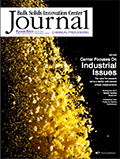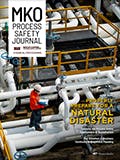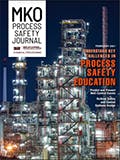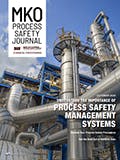Chemical Processing has collaborated with well-known institutions to develop journals to help you better understand and solve challenges. These journals will help you make your plants more efficient, safe, environmentally friendly and economically competitive.
Bulk Solids Innovation Center Journal
Bulk Solids Innovation Center Journal: Consider Pneumatic Conveying Without Air
Whether you're deciding to not use air for pneumatic conveying or looking for guidance on bulk-material handling, there are many things to consider.
Chemical Processing in collaboration with the Bulk Solids Innovation Center has developed this Journal to help you better understand bulk solids processing and solve your challenges.
It includes insight on:
- Consider Pneumatic Conveying Without Air -- Explore alternative medium when oxygen can pose explosion, reaction or other issues
- Don’t Fall Short With Transfer Chutes -- Understand key points about these bulk-material-handling units
- Select the Right Valves for Dilute-Phase Conveying -- Consider a number of factors when you must divert or converge streams
- Succeed in 3-D Printing/Additive Manufacturing -- Understanding metal powder characteristics is crucial
Bulk Solids Innovation Center Journal: Effectively Use Cyclones for Particulate Air Pollution Control
Dry mixing plays an important role in many processes. The operation can take place at different stages of a process, for example at the beginning to mix raw materials or at the end to disperse additives into a product. Regardless, the purpose of the mixer remains the same: creating a mixture homogeneous enough for the intended application.
Chemical Processing in collaboration with the Bulk Solids Innovation Center has developed this Journal to help you better understand bulk solids processing and solve your challenges.
Understand Flowability, Flow Function and Flow Factor
Understanding material flow is a key requirement for the powder and bulk solids industry. The storage, handling and production span a range of process applications and require a good understanding of material flow properties and flow behavior. The industry knows that conveying powders and solids is complex, and conditions continually are changing due to variability in material properties for various reasons, affecting successful materials handling operations.
Chemical Processing in collaboration with the Bulk Solids Innovation Center has developed this Journal to help you better understand bulk solids processing and solve your challenges.
It includes insight on:
- Calculating the best size for your bulk solids rectangular storage bin
- Phase changes in the downstream processing and handling of solids
- Determining the right valve for your application
- Selecting the right drying system for agglomerating bulk solids
- Understanding flowability, flow function and flow factor
- A case study on biomass testing
- Successfully conveying calcium carbonate in plastics compounding
- A pictorial tour of the KSU-BSIC materials property labs
Bulk Solids Innovation Center Journal: Calculate the best size for your round silo or bin
Silos and bins are some of the most common pieces of equipment in any plant that produces or uses bulk solid materials. Determining the proper size is not difficult, but it requires some calculations.
Chemical Processing in collaboration with the Bulk Solids Innovation Center has developed this Journal to help you better understand bulk solids processing and solve your challenges. It includes insight on:
- Calculating the best size of your round silo or bin
- How a properly designed fluid-bed dryer can handle sticky solids
- Understanding the types of services that outside experts offer
- Evaluating secondary dust explosion hazards
- Why a plant Banished blend binding
- How to profit from pilot testing
- Considering pneumatic conveying to divert dry material
- How a food production facility got modernized
- and more.
Bulk Solids Innovation Center Journal: Center focuses on Industrial Issues
Everyone who has worked with bulk solids knows that they are a challenge and are much less predictable than liquids or gases. Methods that work with one material don’t work with another and may not even work in the same process if environmental conditions change, if you try to run it in a different season of the year, or if you change material vendors.
Chemical Processing in collaboration with the Bulk Solids Innovation Center has developed this Journal to help you better understand bulk solids processing and solve your challenges. It includes insight on:
- How the Bulk Solids Innovation Center Came to Be: The need for bulk solids research prompted its formation
- Powder Handling: Beware of Blending Myths: But first determine if blending really is required
- Prolong the Life of Material Handling Equipment: A variety of techniques can prevent wear and abrasion
- Understand the Key Role of Bulk Solids Testing: Getting suitable data underpins success in material handling
- Troubleshoot Your Feeder for Optimal Performance: Understand key factors affecting volumetric and loss-in-weight units
MKO Process Safety Journal
See Risk More Clearly
The belief that all loss events are foreseeable, given sufficient analysis, is very alluring. Throughout the life of a manufacturing process opportunities exist to examine risk, apply more complex methods, and give hazard scenarios and their avoidance more thought. However, the reality is that most people have difficulty thinking outside the box and honestly looking at how the process can misbehave. It’s easy to accept that if nothing has happened before, nothing will happen in the future. The harsh truth is that a hazardous situation still can occur.
Chemical Processing in collaboration with the Mary Kay O'Connor Process Safety Center has developed this Journal to help you better understand process safety management and solve your challenges. It includes insight on:
- Avoiding a number of common errors that can blur your vision
- How increased awareness can benefit engineers and the public process
- How to predict properties using machine learning
- How to use elegant design to bolster inherent safety
Properly prepare for a natural disaster
The 2017 hurricane season was one of the most expensive in U.S. history, exceeding $200 billion in damages. In 2018, the world watched as Hurricanes Florence and Michael wreaked havoc in North Carolina and the Florida Panhandle. Hurricane Michael was recorded as the strongest storm to make landfall in the U.S. since Hurricane Andrew in 1992. Is your facility prepared to handle future natural disasters? Discover how to take some sensible steps now to avoid issues with hazardous wastes.
Chemical Processing in collaboration with the Mary Kay O'Connor Process Safety Center has developed this Journal to help you better understand process safety management and solve your challenges. It includes insight on:
- Properly preparing for a natural disaster
- Understanding and reducing the impact of rare events
- Considering the process safety implications of digitalization
- Performing a proper pre-startup safety review
- Paying attention to business continuity management planning
- Process safety training program targeting Incumbent workers
- Survey benchmarks safety culture surveys
Understand Key Challenges in Process Safety Education
Process safety academic education has evolved slowly over the past four decades.
University chemical engineering departments began to establish and deliver process safety courses in the 1980s. However, the majority of chemical engineering curricula still do not offer a standalone course, and fewer make it a requirement.
Chemical Processing in collaboration with the Mary Kay O'Connor Process Safety Center has developed this Journal to help you better understand process safety management and solve your challenges. It includes insight on:
- Predicting and preventing well-control events
- 5 Steps for running accident investigations right
- Succeeding at setting up a virtual event
- Leveraging optimization in process safety decision-making
- Rethinking safety and control system designs
Understand The Importance Of Process Safety Management Systems
What systems are in place to prevent an accident from happening at your plant?
Answering this question requires understanding the concepts of “hazards,” “risk,” “risk acceptability” and “safety.” Every operating plant is faced with managing a number of hazards related to the materials handled and the chemicals used in to process feedstock into marketed products. They also must deal with hazards associated with the equipment and the conditions in the plant. How a facility manages these hazards and the associated risks will determine whether the operation is “safe.”
Chemical Processing in collaboration with the Mary Kay O'Connor Process Safety Center has developed this Journal to help you better understand process safety management and solve your challenges. It includes insight on:
- Getting the best out of incident data
- Effectively sharing insights from incidents
- Industrial detonations in vapor cloud explosions
- Rethinking your process safety procedures
- Boosting your process plants resilience
- Ending abandon in-place procedures
- Why the emerging hydrogen economy demands attention








